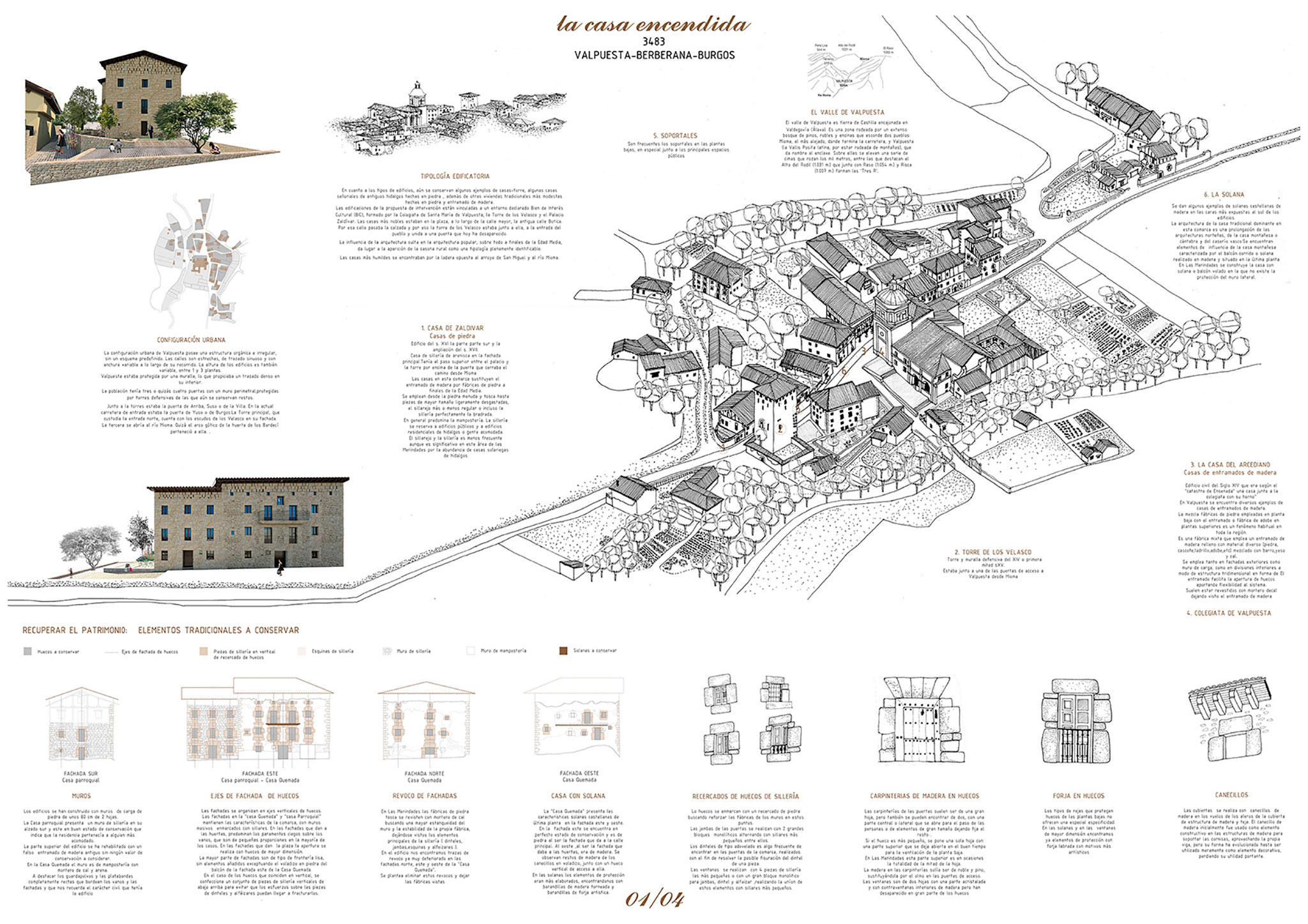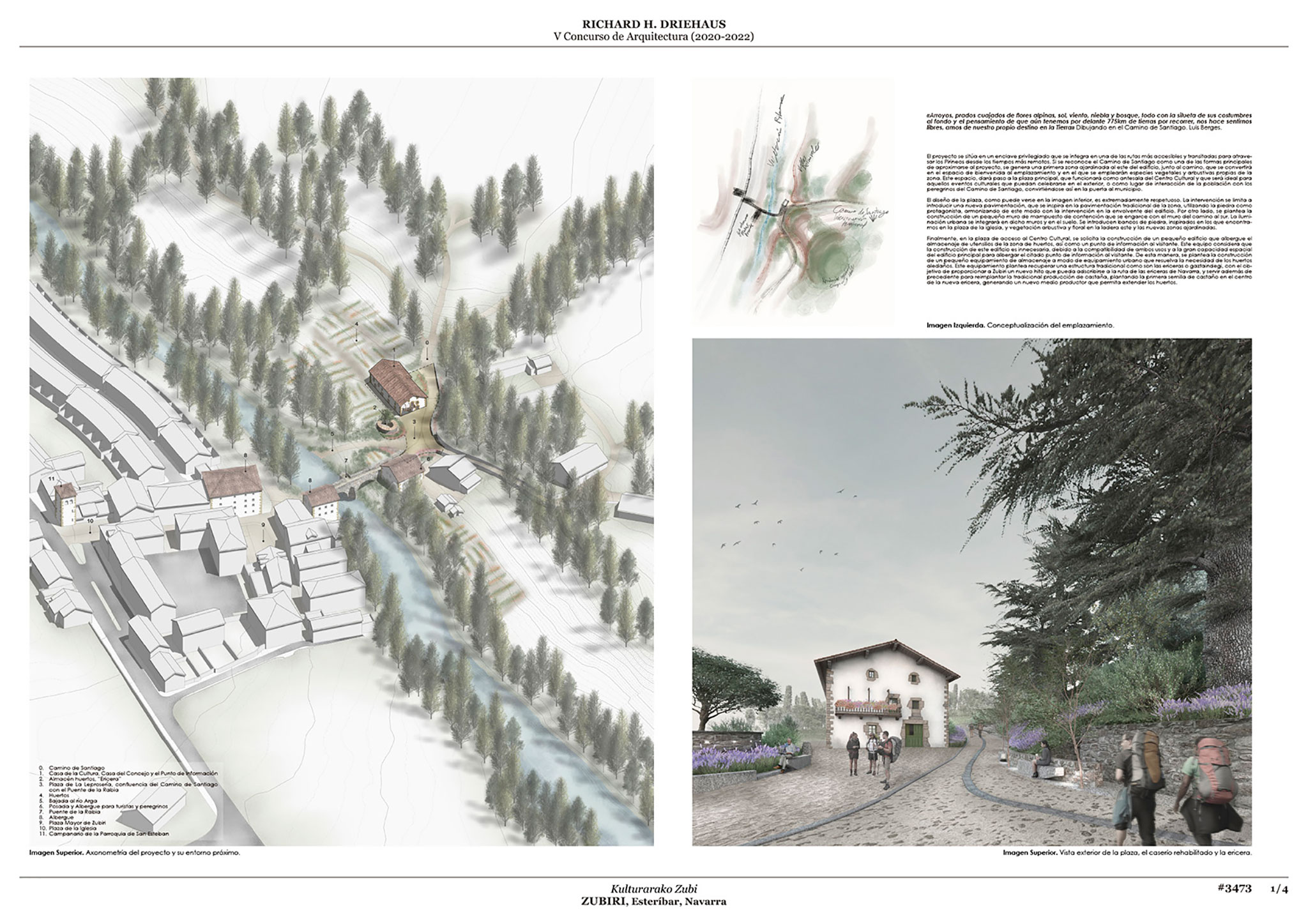Richard H. Driehaus Architecture Contest celebrates its fifth edition by selecting the winners, awarding €50,000 in prizes to proposals that promote and preserve local traditions, in terms of construction and resources, Spanish cultural heritage, and economic and material sustainability.
Among the 39 proposals submitted from all over the world, those that best met the above-mentioned criteria and most efficiently meet the needs of the three municipalities selected in the first phase of the competition were selected.
The winning architectural projects respond to the needs of the three municipalities chosen by the international jury in the first phase of the competition, which was designated for the possibility of improving and creating new resources and activities to make them more attractive to the population.
The competition consists of two successive phases.
In the first phase, Spanish municipalities are invited to submit possible themes and sites for the recovery, preservation, and revitalization of their localities. From among the 30 proposals received, an international jury has chosen the three that best meet the objectives and criteria set out and that has been considered the most viable in terms of their possible application or subsequent implementation.
In the second phase of the competition, in this case of an international nature, architectural firms from around the world were invited to submit architectural and urban design proposals for the three sites initially selected.
A second international jury, in which the different institutions collaborating in this initiative and the authorities of the municipalities involved were once again represented, evaluated the proposals and selected the ones that best met the competition criteria.
The winners of this edition are listed below.

The winning project from the municipality of Valpuesta.
The design proposed by Susana Granizo Polo and Silvia N. Gómez Díaz was the winning design in the municipality of Valpuesta (Burgos). The project proposes the recovery of a group of buildings located in the main public space of the place, which is reactivated and revitalized with this intervention.
New cultural facilities will be created in the renovated buildings. They will house, among other uses, a study center on the origin of the Castilian language, some of the oldest manifestations of which were found in this place.

Winning project for the municipality of Buitrago del Lozoya.
The winning project for Buitrago del Lozoya, designed by the architect Javier Senosiain Jauregui, proposes the reconstruction and recovery of an entire block of its historic quarter that is in ruins and the creation of new quality public spaces that will attract new activity to this area of the municipality.
These buildings, whose design updates the forms and construction systems of the local tradition, will be used as municipal tourist accommodation.

The winning project in the municipality of Zubiri.
In the case of Zubiri, the prize went to the proposal by Francisco Sánchez Salazar, Miguel Antonio García, and Jesús Llanos Jiménez, which seeks to recover a large stone building situated next to the Camino de Santiago and currently abandoned, to convert it into the town's cultural center.
Respecting its structure and original materials, its interior is transformed to create various spaces that support the revitalization of this area. The square in which it is located is also being enhanced and new construction is being built to support the adjacent neighborhood vegetable gardens.
Among the 39 proposals submitted from all over the world, those that best met the above-mentioned criteria and most efficiently meet the needs of the three municipalities selected in the first phase of the competition were selected.
The winning architectural projects respond to the needs of the three municipalities chosen by the international jury in the first phase of the competition, which was designated for the possibility of improving and creating new resources and activities to make them more attractive to the population.
The competition consists of two successive phases.
In the first phase, Spanish municipalities are invited to submit possible themes and sites for the recovery, preservation, and revitalization of their localities. From among the 30 proposals received, an international jury has chosen the three that best meet the objectives and criteria set out and that has been considered the most viable in terms of their possible application or subsequent implementation.
In the second phase of the competition, in this case of an international nature, architectural firms from around the world were invited to submit architectural and urban design proposals for the three sites initially selected.
A second international jury, in which the different institutions collaborating in this initiative and the authorities of the municipalities involved were once again represented, evaluated the proposals and selected the ones that best met the competition criteria.
The winners of this edition are listed below.

The winning project from the municipality of Valpuesta.
The design proposed by Susana Granizo Polo and Silvia N. Gómez Díaz was the winning design in the municipality of Valpuesta (Burgos). The project proposes the recovery of a group of buildings located in the main public space of the place, which is reactivated and revitalized with this intervention.
New cultural facilities will be created in the renovated buildings. They will house, among other uses, a study center on the origin of the Castilian language, some of the oldest manifestations of which were found in this place.

Winning project for the municipality of Buitrago del Lozoya.
The winning project for Buitrago del Lozoya, designed by the architect Javier Senosiain Jauregui, proposes the reconstruction and recovery of an entire block of its historic quarter that is in ruins and the creation of new quality public spaces that will attract new activity to this area of the municipality.
These buildings, whose design updates the forms and construction systems of the local tradition, will be used as municipal tourist accommodation.

The winning project in the municipality of Zubiri.
In the case of Zubiri, the prize went to the proposal by Francisco Sánchez Salazar, Miguel Antonio García, and Jesús Llanos Jiménez, which seeks to recover a large stone building situated next to the Camino de Santiago and currently abandoned, to convert it into the town's cultural center.
Respecting its structure and original materials, its interior is transformed to create various spaces that support the revitalization of this area. The square in which it is located is also being enhanced and new construction is being built to support the adjacent neighborhood vegetable gardens.
















































